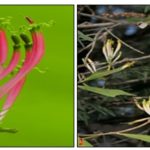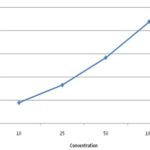ANTIMICROBIAL AND ANTIOXIDANT POTENCY OF DENDROPTHOE FALCATA LINN.
HTML Full TextANTIMICROBIAL AND ANTIOXIDANT POTENCY OF DENDROPTHOE FALCATA LINN.
M. P. Chaudhari *, R. A. Ghode, K. D. Bhalani, Siddhi U. Upadhyay and Umesh M. Upadhyay
Sigma Institute of Pharmacy, Bakrol, Baroda - 390019, Gujarat, India.
ABSTRACT: The World Health Organization survey indicated that about 70-80% of the world’s populations rely on non-conventional medicine, mainly of herbal sources, in their primary healthcare. Among them parasitic plants are well known, 20 different species are belonging to the genus Dendrophthoe falcate (Loranthaceae) found all over the world, seven of which are found in India. The hemiparasite, Dendrophthoe falcata (L.f.) is one of the seven species present in India. It is used in the treatment of ulcer, asthma, pulmonary TB, wound healing, menstrual disorder, also used as an aphrodisiac. The water extract of Dendropthoe falcata showed satisfactory antimicrobial activity against gram-positive strains Staphylococcus aureus, Bacillus subtilis and gram-negative strains Escherichia coli; while methanolic extract of Dendropthoe falcata shows satisfactory antioxidant activity.
| Keywords: |
A parasitic plant, Dendropthoe falcate, Extract, Antioxidant, Antimicrobial
INTRODUCTION: For most of the developing world, the main issue of public health is still the acute need for basic health care, which is sadly lacking even at the most elementary level. This is true in both the rapidly growing cities and the rural areas. In many developing countries traditional medicine is one of the primary health care systems 1, 2. The WHO estimates that more than 80% of the world’s population rely either solely or largely on traditional remedies for health care. Plant Dendropthoe falcata (Loranthaceae), seen in Fig. 1 and Fig. 2, is found in tropical regions especially in India, Srilanka, China, Australia, Bangladesh, Malaysia and Myanmar 3. Dendropthoe falcata is a large bushy parasitic shrub with grey bark, thick usually opposite leaves, orange-red or scarlet flowers and ovoid-oblong berries 5.
Chemically, quercitrin (Quercetin - 3 - O -Rhamnoside) is a major constituent in Dendropthoe falcata on different host plants 6. The three cardiac glycosides are also isolated from the plant, viz. Strospeside, odoroside F and neritaloside are reported from the leaves 7. Flavonoids found are quercetin, kaempferol, quercitrin, hyproside, and rutin from different parts of plant Tannins comprising of gallic and chebulinic acid 8, 9. Ethnobotanically, it is used in the treatment of ulcer, asthma, pulmonary TB, menstrual disorder, the contraceptive activity of methanol extract of Dendrophthoe falcata stem in male albino rats 10. A decoction of the plant is used by women as an antifertility agent, also have anti-cancer activity 11. It is also used as an aphrodisiac, healing of wounds. It also shows anti-inflammatory activity. In-vitro, antioxidant activities were also investigated by using in-vitro antioxidant model 12.
The alcoholic extract of the plant was found to have antidiuretic activity, and the hepatoprotective activity and the preliminary cytotoxic activity of the plant was tested by the brine shrimp assay 13. The phytochemical screening of the plant alcoholic extract and the antimicrobial activity also tested against the S. aureus, Bacillus subtilis, E. coli, and the recently the plant is found to have antifertility activity in the rats. Members of genus Dendropthoe are reported to have antioxidant, anti-microbial, anticancer and anti-diabetic activity 14. It treats kidney stones 15 also have diuretic and antilithiatic activity 16.
FIG. 1 AND 2: PHOTOGRAPH OF DENDROPTHOE FALCATA 4
The Principle of Anti-Microbial Activity: It is well established that several secondary metabolites synthesized by the plants play a central role in plant defense against microbial attack. The plant extracts have been found to possess a wide range of action on different gram +ve and gram -ve micro-organisms. The extract selected under the present study was the water extract which showed the inhibition of the microbial colonies on the nutrient medium 17.
The Principle of Antioxidant Activity: Antioxidants play an important role in the removal of free radicals. Free radicals and other oxygen derivatives are constantly generated in-vivo both by accident of chemistry and for specific metabolic purposes. The reactivity of different free radicals varies with many causing inflammation or even severe damage to DNA, lipids, proteins. Antioxidants are the substances used in a small amount which prevent or greatly retard oxidation of easily oxidizable material. These have various mechanisms such as suppressing formation of active species by reducing hyper peroxides, by sequestering metal ions scavenging active free radicals, etc. 18
MATERIALS AND METHODS:
Plant Material Collection: The plant material of Dendropthoe falcata (Loranthaceae) was collected from the botanical garden of Sigma Institute of Pharmacy, Bakrol; Baroda in November 2009. The plant material was cleaned thoroughly with water and made free from soil and dust. Then these fresh plant leaves were used for extraction.
Preparation of Extract for Antimicrobial Activity: The fresh leaves (100 g) were cut into small pieces and extracted with 500 ml of water for 6 h. Then the extract was filtered and concentrated to obtain the residue. The residue was collected and weighed. The % yield was found to be 17.34% (w/v).
Antimicrobial Activity: The antimicrobial activity was performed using gram-positive strains Staphylococcus aureus, Bacillus subtilis and gram-negative strains Escherichia coli. The assay was done by agar disk method. The concentrations 200, 400, 800 µg/ml was prepared in 1% DMSO solution. Agar medium was sterilized. The test microorganisms were spread on top of agar medium in the flame sterilized area.
The discs containing dilutions of above-mentioned concentrations of solutions were placed on the agar plates. All the plates were incubated in an incubator at 32 °C - 35 °C for 24 h. A zone reader recorded zone of inhibition after 24 h of incubation 19.
Preparation of Extract for Antioxidant Activity: The fresh leaves (100 g) were cut into small pieces and cold macerated with 100 ml of methanol for 24 h. Then the extract was filtered and evaporated to dryness. The residue was collected and weighed. The % yield was found to be 5.57% (w/v).
Antioxidant Activity: 1 ml of different concentrations of extract (10, 25, 50, 100 µg/ml), were taken. 2.5 ml of phosphate buffer (0.25M) was added to each one of it. 2.5 ml of potassium ferricyanide (1% w/v) was added to each one of it. These solutions were then incubated at 50 °C for 20 min. 2.5 ml of TCA was added and centrifuged at 3000 rpm for 10 min. Then 2.5 ml of the supernatant was taken and 2.5 ml of distilled water and 0.5 ml of ferric chloride solution (0.1% w/v) were added to it. The absorbance was measured at 760 nm 20, 21.
RESULTS AND DISCUSSION:
TABLE 1: DESCRIBES COMPARISON OF ANTIMICROBIAL ACTIVITY OF AQUEOUS EXTRACT WITH STANDARD SHOWING 19
| Solvent | Conc.
(µg/ml) |
Zone of inhibition (mm) | ||
| S. aureus | B. subtilis | E. coli | ||
| Negative control | 10000 | 1.3 | 1.1 | 1.0 |
| Positive control | 20 | 12.1 | 14 | 12 |
| Aqueous extract | 200 | 13 | 10.9 | 10.5 |
| 400 | 6.5 | 6.4 | 6.0 | |
| 800 | 6.7 | 6.6 | 6.2 | |
TABLE 2 AND FIG. 3: SHOWS COMPARISON OF ANTIOXIDANT ACTIVITY OF ALCOHOL EXTRACT WITH STANDARD SHOWING 21
| S. no. | Sample | Conc. (µg/ml) | Absorbance ( at 700 nm ) |
| 1 | Ascorbic acid | 10 | 0.090 |
| 20 | 0.122 | ||
| 30 | 0.141 | ||
| 40 | 0.162 | ||
| 60 | 0.191 | ||
| 80 | 0.224 | ||
| 2 | Alcohol extract | 10 | 0.445 |
| 25 | 0.827 | ||
| 50 | 1.420 | ||
| 100 | 2.197 |
FIG. 3: GRAPHICAL PRESENTATION OF ANTIOXIDANT ACTIVITY
CONCLUSION: Preliminary study concludes that water extract of Dendropthoe falcata showed satisfactory antimicrobial activity against gram-positive strains Staphylococcus aureus, Bacillus subtilis and gram-negative strains Escherichia coli; while methanolic extract of Dendropthoe falcata shows satisfactory antioxidant activity.
ACKNOWLEDGEMENT: Nil
CONFLICT OF INTEREST: Nil
REFERENCES:
- Fransworth NR: Ethnopharmacology and future drug development, The North American experience. Journal Ethnopharmacol 1993; 38: 45-152.
- Houghton PJ: The role of plants in traditional medicine and current therapy. J Altern and Complement Med 1995; 1: 131-143.
- Rangari VD: Pharmacognosy and Phytochemistry. Nasik Career publication, Edition 1st, Part I, 2002: 180-235.
- Wikimedia Commons
- The Wealth of India Raw Material: A Dictionary of Indian Raw material and Industrial Products. Council of Scientific Indian Research. New Delhi 1952; 3(D-E): 34-35.
- Boonsong C and Wright SE: The cardiac glycosides present in mistletoe growing on Nerium oleander. Aust J Chem 1961; 14(3): 449-451.
- Nair Ramachandran AG and Krishnakumary P: Flavanoids of Dendropthoe falcata Ettingsh growing on different host plants. Indian J Chem 1989; 29(B): 584-585.
- Mallavadhani UV, Narashimhan K, Mohapatra A and Breeman RBV: New pentacyclic triterpenes and some Flavanoids from the fruits of Indian ayurvedic plant Dendrophthoe falcata and their receptor binding activity. Chem. Pharm Bull 2006; 54(5): 740-744.
- Rastogi RP and Mehrotra BN: Compendium of Indian Medicinal Plants, PID, New Delhi, 1993; 3: 240.
- Gupta RS and Kachhawa JBS: Evaluation of the contraceptive activity of methanol extract of falcata stem in male Albino rats. J Ethnopharmacology 2007; 112(1): 215-218.
- Kokate CK: Practical Pharmacognosy, Vallabh Prakashan, Delhi, Edition 4th, 1997: 107-111.
- Pattanayak SP and Sunita P: Wound healing, anti microbial and in-vivo antioxidant activity of Dendropthoe falcata (L.F.) Ettingsh. J Ethnopharmacol 2008; 8: 19. Doi: 10.101/J. jep.2008.08.019.
- Solis P, Wright C, Anderson M, Gupta M and Philippson JA: Microwell cytotoxicity assay using Aremia salina (Brine shrimp). Planta Med 1993; 59: 250-252.
- Osadebe PO, Okide GB and Akaboug ICJ: Ethnopharmacol 2004; 95: 133-138.
- Singh VK and Ali ZK: A contribution to the ethnopharmacological study of the Udaipur forests of Rajasthan, India. Fitoterapia 1992; 63: 136-144.
- Alkutti NA, Srinivasan KK and Gandu RP: Diuretic and antilithiatic activity of Dendropthoe falcata. Fitoterapia 1993; 64: 325-331.
- Bhakani DS, Goyal AK and Jain S: Screening of Indian Plants for biological activity of Dendropthoe falcata. Ind J Exp Biol 1998; 26: 833-904.
- Patil S, Anarthe S, Jadhav R and Surana S: Evaluation of anti-inflammatory activity and in-vitro antioxidant activity of Indian mistletoe, the hemi parasite Dendropthoe falcataF. (Loranthaceae). Iranian J of Pharmaceutical Research 2011; 10(2): 253-259.
- Pattanayak SP and Sunita P: Wound healing, anti- microbial and in-vivo antioxidant activity of Dendropthoe falcata (L.F.) Ettingsh. J Ethnopharmacol 2008; 8: 19. doi: 10.101/J. jep.08.019.
- Pattanayak SP, Sunita P, Muzumdar PM and Panda PK: Total phenolic content, flavanoids content and in-vitro antioxidant activities of Dendropthoe falcata (L.F.) Ettingsh. Int J of Pharm Tech Research 3: 1392-1406.
- Dashora N, Sodde V and Kirti: Antioxidant activity of Dendropthoe falcate (L.f) Etting. Pharmaceutical Crops 2011; 2: 24-27.
How to cite this article:
Chaudhari MP, Ghode RA, Bhalani KD, Upadhyay SU and Upadhyay UM: Antimicrobial and antioxidant potency of Dendropthoe falcata Linn. Int J Pharmacognosy 2014; 1(8): 512-15. doi link: http://dx.doi.org/10.13040/IJPSR.0975-8232.IJP.1(8).512-15.
This Journal licensed under a Creative Commons Attribution-Non-commercial-Share Alike 3.0 Unported License.
Article Information
5
512-515
516
2120
English
IJP
M. P. Chaudhari *, R. A. Ghode, K. D. Bhalani , S. U. Upadhyay and U. M. Upadhyay
House no: 134/1, Behind Swaraj aashram Vedachchi, Mahendrabhai’s faliya, Ta: Valod, Di: Tapi, India.
minal2404@gmail.com
26 June 2014
22 July 2014
28 July 2014
http://dx.doi.org/10.13040/IJPSR.0975-8232.IJP.1(8).512-515
01 August 2014





